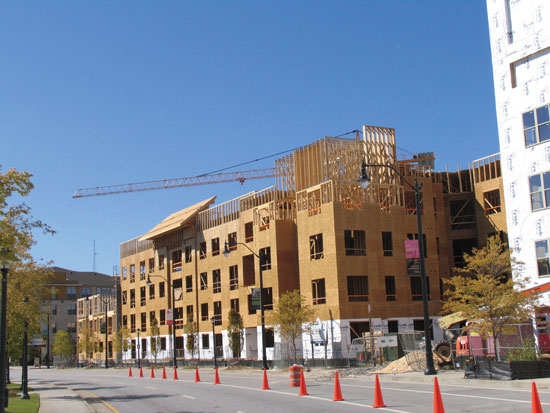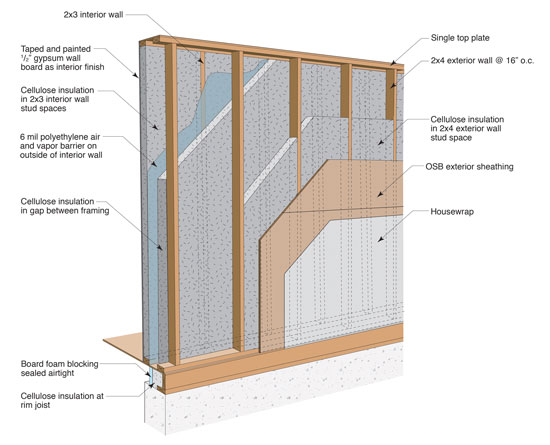Energy Efficient Wood Buildings
Air Barriers
The control of air flow through the use of air-barrier systems is important to, among other things, minimize the loss of conditioned air through the building enclosures. Air-barrier systems are required for all multi-unit residential buildings in all climate zones.
The air barrier is the means of preventing air leakage through the building envelope. A building’s air barrier should be continuous, integrating all the exterior envelope systems—e.g., the wall air barrier with the roof air barrier, etc. The air barrier can be installed on the interior or exterior of the building envelope. An efficient and cost-effective way to achieve an effective air barrier on walls is to incorporate a continuous, solid layer on the exterior of a building. The continuous solid material should be stiff enough to minimize the amount of deflection when pressure is applied to tape or sealants in order to create an effective seal when applied to panel joints and around wall penetrations. Panel joints need to be properly sealed to complete an air barrier assembly.
Continuous wood structural panel sheathing is commonly used as part of an air barrier system for exterior walls. The architect typically details how panel joints and openings are to be sealed—usually with tape or sealant specifically recommended for use on plywood or oriented strand board (OSB). Using continuous structural sheathing as part of the air barrier system also provides a solid support base for exterior cladding systems while increasing the structure’s earthquake and wind resistance.

Photo courtesy of APA – The Engineered Wood Association
The exterior, sealed sheathing air barrier approach meets the key requirements of an effective air barrier system—i.e., that all elements (materials) be air-impermeable, that it be continuous throughout the building enclosure, structurally adequate and sufficiently rigid, and that it have a service life as long as that of the wall and roof assembly components.
When using continuous wood structural panels as the air barrier:
- Panels should not be glued directly to framing. This approach is restricted in high Seismic Design Categories per the American Wood Council’s Special Design Provisions for Wind and Seismic (SDPWS) Section 4.3.6.1. Gluing wall sheathing to framing also restricts wood panels from expanding as moisture is absorbed, which can contribute to out-of-plane buckling.
- Make sure that any sealant or tape used to complete the air barrier does not impede the ability of the panels to expand when exposed to increased humidity in the wall cavity or wetting due to construction delays. Anything that prevents panel expansion into the recommended 1/8-inch spacing between panels could result in buckling of the wall sheathing. Also, make sure the tape is rated to be used as part of an air barrier system.
- A water-resistive barrier, such as housewrap, should always be installed over wood structural panel wall sheathing in order to direct any moisture that penetrates the cladding away from the sheathing and wall cavity.
Unlike vapor barriers, there is little to no downside of redundancy in the air barrier provided the materials used do not negatively impact vapor flow. In fact, some designers incorporate more than one continuous air barrier—one on the building interior and one on the exterior.
Architectural Form
Multi-story wood-frame architecture varies across the United States, with designs based on the architect’s response to the client brief, site conditions, and local environment. Consideration of orientation, building form, and massing, as well as the ratios of enclosure area to volume, are essential factors in achieving energy-efficient designs. The use of building features to protect the enclosure is a fundamental architectural design principle. Roof overhangs, balconies, and other projections shelter walls, windows, and doors from driving rain, wind, snow, and ice, and provide solar shading.
Wood Construction and the IECC
While, historically, energy-efficiency strategies have tended to focus on HVAC systems, new energy codes such as the IECC have placed increasing emphasis on the thermal performance of building enclosures.
When designing a building, architects have three main paths for obtaining compliance with the 2012 IECC:
- IECC prescriptive path
- IECC performance path
- ASHRAE 90.1 path
For either IECC path, certain sections of the code are mandatory. These include requirements specific to air leakage in the thermal envelope (Section C402.5), space conditioning and ventilation (Section C403.2), service water heating (Section C404), and electrical power and lighting systems (Section C405). Using the path outlined in the ASHRAE Standard 90.1-2010 (ASHRAE 90.1), developed jointly by the American National Standards Institute (ANSI), American Society of Heating, Refrigerating and Air-Conditioning Engineers (ASHRAE), and Illuminating Engineering Society of North America (IESNA), designers are not required to comply with the mandatory sections of the IECC; however, ASHRAE 90.1 has its own mandatory sections.
An above-code program, when deemed to meet or exceed code requirements by the code official, is a fourth compliance path. All mandatory sections of the IECC are still required to be met.
R-Value Requirements for Multi-Unit Residential Buildings
Minimum R-value requirements for above-grade wood-frame building enclosure assemblies in the 2012 IECC are provided for “commercial” buildings in IECC Table C402.2 (see page 7). They are broken down by climate zone, as defined in the U.S. Department of Energy’s climate zone map. Residential buildings have more stringent requirements based on climate zone.











